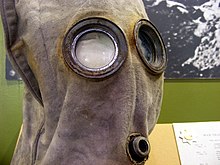
A gas mask is an item of personal protective equipment used to protect the wearer from inhaling airborne pollutants and toxic gases. The mask forms a sealed cover over the nose and mouth, but may also cover the eyes and other vulnerable soft tissues of the face. Most gas masks are also respirators, though the word gas mask is often used to refer to military equipment, the scope used in this article. The gas mask only protects the user from digesting, inhaling, and contact through the eyes. Most combined gas mask filters will last around 8 hours in a biological or chemical situation. Filters against specific chemical agents can last up to 20 hours.
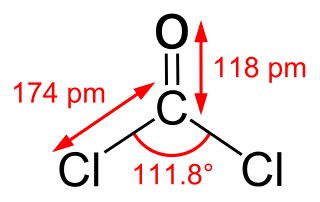
Phosgene is an organic chemical compound with the formula COCl2. It is a toxic, colorless gas; in low concentrations, its musty odor resembles that of freshly cut hay or grass. It can be thought of chemically as the double acyl chloride analog of carbonic acid, or structurally as formaldehyde with the hydrogen atoms replaced by chlorine atoms. Phosgene is a valued and important industrial building block, especially for the production of precursors of polyurethanes and polycarbonate plastics.

Chemical warfare (CW) involves using the toxic properties of chemical substances as weapons. This type of warfare is distinct from nuclear warfare, biological warfare and radiological warfare, which together make up CBRN, the military acronym for chemical, biological, radiological, and nuclear, all of which are considered "weapons of mass destruction" (WMDs), a term that contrasts with conventional weapons.

The use of toxic chemicals as weapons dates back thousands of years, but the first large-scale use of chemical weapons was during World War I. They were primarily used to demoralize, injure, and kill entrenched defenders, against whom the indiscriminate and generally very slow-moving or static nature of gas clouds would be most effective. The types of weapons employed ranged from disabling chemicals, such as tear gas, to lethal agents like phosgene, chlorine, and mustard gas. These chemical weapons caused medical problems. This chemical warfare was a major component of the first global war and first total war of the 20th century. The killing capacity of gas was limited, with about 90,000 fatalities from a total of 1.3 million casualties caused by gas attacks. Gas was unlike most other weapons of the period because it was possible to develop countermeasures, such as gas masks. In the later stages of the war, as the use of gas increased, its overall effectiveness diminished. The widespread use of these agents of chemical warfare, and wartime advances in the composition of high explosives, gave rise to an occasionally expressed view of World War I as "the chemist's war" and also the era where weapons of mass destruction were created.

Diphosgene is an organic chemical compound with the formula ClCO2CCl3. This colorless liquid is a valuable reagent in the synthesis of organic compounds. Diphosgene is related to phosgene and has comparable toxicity, but is more conveniently handled because it is a liquid, whereas phosgene is a gas.
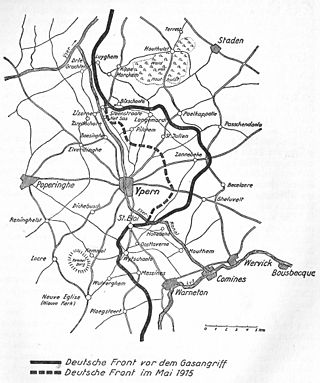
During the First World War, the Second Battle of Ypres was fought from 22 April – 25 May 1915 for control of the tactically important high ground to the east and south of the Flemish town of Ypres in western Belgium. The First Battle of Ypres had been fought the previous autumn. The Second Battle of Ypres was the first mass use by Germany of poison gas on the Western Front.

Colonel Cluny Macpherson was a physician and the inventor of an early gas mask. After World War I he served as the president of the St. John's Clinical Society and the Newfoundland Medical Association.
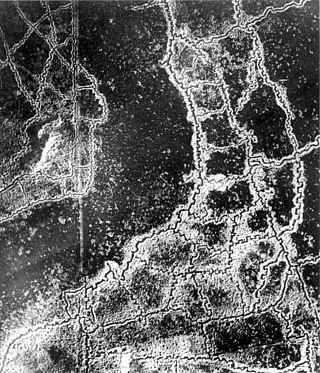
The Gas Attacks at Hulluch were two German cloud gas attacks on British troops during World War I, from 27 to 29 April 1916, near the village of Hulluch, 1 mi (1.6 km) north of Loos in northern France. The gas attacks were part of an engagement between divisions of the II Royal Bavarian Corps and divisions of the British I Corps.

The Hypo helmet, or British Smoke Hood, was an early British World War I gas mask, designed by Cluny Macpherson.
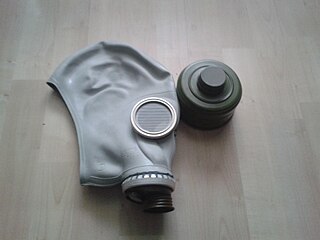
The GP-5 gas mask kit is a Soviet-made gas mask kit, which contains a single-filter ShM-62 or Shm-62U gas mask. It was issued to the Soviet population starting in 1962 during the Cold War. Production of the kit ended in 1990. The number of GP-5 kits produced was three times more than the population of the Soviet Union. The GP-5 kit was originally made to protect the wearer from radioactive fallout from the Cold War and was distributed to most fallout shelters. They were tested in Poland to determine if they have NBC protective capabilities. It was concluded that the mask would last in an NBC situation for 24 hours.

The M2 gas mask was a French-made gas mask used by French, British and American forces from April 1916 to August 1918 during World War I. The M2 was fabricated in large quantities, with about 29,300,000 being made during the war. It was intended to protect the wearer from at least five hours' exposure to phosgene gas, a common chemical weapon of the time.
Chemical weapons were widely used by the United Kingdom in World War I. The use of poison gas was suggested by Winston Churchill and others in Mesopotamia during the interwar period, and also considered in World War II, although it appears that they were not actually used in these conflicts. While the UK was a signatory of the Hague Conventions of 1899 and 1907 which outlawed the use of poison gas shells, the conventions omitted mention of deployment from cylinders.

The German phosgene attack of 19 December 1915 was the first use of phosgene gas against British troops by the German army. The gas attack took place at Wieltje, north-east of Ypres in Belgian Flanders on the Western Front in the First World War. German gas attacks on Allied troops had begun on 22 April 1915, during the Second Battle of Ypres using chlorine against French and Canadian units. The surprise led to the capture of much of the Ypres Salient, after which the effectiveness of gas as a weapon diminished, because the French and British introduced anti-gas measures and protective helmets. The German Nernst-Duisberg-Commission investigated the feasibility of adding the much more lethal phosgene to chlorine. Mixed chlorine and phosgene gas was used at the end of May 1915 against French troops and on Russian troops on the Eastern Front.

The Gas attacks at Wulverghem were German cloud gas releases during the First World War on British troops at Wulverghem in the municipality of Heuvelland, near Ypres in the Belgian province of West Flanders. The gas attacks were part of the sporadic fighting between battles in the Ypres Salient on the Western Front. The British Second Army held the ground from Messines Ridge northwards to Steenstraat and the divisions opposite the German XXIII Reserve Corps had received warnings of a gas attack. From 21 to 23 April, British artillery-fire exploded several gas cylinders in the German lines around Spanbroekmolen, which released greenish-yellow clouds. A gas alert was given on 25 April when the wind began to blow from the north-east and routine work was suspended; on 29 April, two German soldiers deserted and warned that an attack was imminent. Just after midnight on 30 April, the German attack began and over no man's land, a gas cloud drifted on the wind into the British defences, then south-west towards Bailleul.
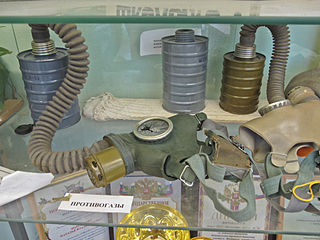
The GP-4u gas mask was one of the most widely produced gas masks in the USSR.

Hazmat diving is underwater diving in a known hazardous materials environment. The environment may be contaminated by hazardous materials, the diving medium may be inherently a hazardous material, or the environment in which the diving medium is situated may include hazardous materials with a significant risk of exposure to these materials to members of the diving team. Special precautions, equipment and procedures are associated with hazmat diving so that the risk can be reduced to an acceptable level.
The Black Veil Respirator was an early British gas mask designed by John Scott Haldane and introduced in May 1915.
Chemical weapons have been a part of warfare in most societies for centuries. However, their usage has been extremely controversial since the 20th century.
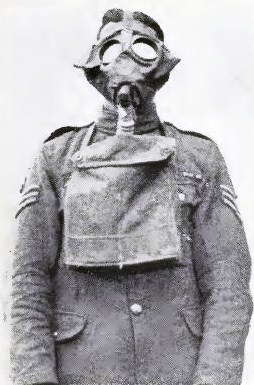
The Small Box Respirator (SBC) was a British gas mask of the First World War and a successor to the Large Box Respirator. In late 1916, the respirator was introduced by the British with the aim to provide reliable protection against chlorine and phosgene gases. The respirator offered a first line of defence against these. The use of mustard gas, was begun by the Germans; a vesicant ("blister agent") that burnt the skin of individuals that were exposed to it. Death rates were high with exposure to both the mixed phosgene, chlorine and mustard gas, however with soldiers having readily available access to the small box respirator, death rates had lowered significantly. Light and reasonably fitting, the respirator was a key piece of equipment to protect soldiers on the battlefield.
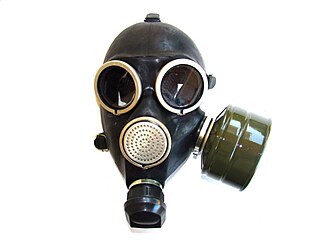
The GP-7 gas mask is a civilian gas mask that was produced by the Soviet Union during the Cold War era. The mask was designed to provide protection to civilians against nuclear, biological, and chemical (NBC) agents during the threat of the Cold War. Its military counterpart, the PMK was intended to be used exclusively for military purposes as opposed to the GP-7 which was designed solely for civil defense.


